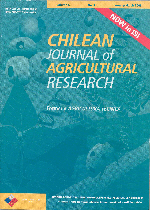
|
Agricultura Técnica
Instituto de Investigaciones Agropecuarias, INIA
ISSN: 0365-2807
EISSN: 0365-2807
Vol. 64, No. 3, 2004, pp. 280-287
|
 Bioline Code: at04030
Bioline Code: at04030
Full paper language: Spanish
Document type: Research Article
Document available free of charge
|
|
|
Agricultura Técnica, Vol. 64, No. 3, 2004, pp. 280-287
| es |
Efecto de la nutrición mineral sobre la producción de culén (Otholobium glandulosum (L.) Grimes)
Hirzel, Juan; Rodríguez, Nicasio & del Valle, Pedro
Resumen
El culén (Otholobium glandulosum (L.) Grimes) es una planta medicinal que ha adquirido gran importancia en los últimos años por su contenido de psolareno. Este estudio tuvo como objetivo generar antecedentes sobre la fertilización de este cultivo. Para tal efecto, se realizó un experimento en macetas con plantas de 2 años, sobre dos substratos de crecimiento, arena de río y suelo trumao (Serie Santa Bárbara, Hashy, mesic typic haploxerands). El ensayo contó con nueve tratamientos de fertilización y cuatro repeticiones en cada substrato. Los tratamientos fueron: fertilización completa (N, P, K, Ca, Mg, S y microelementos), siete tratamientos con fertilización completa excluyendo sólo un nutriente de los señalados, y un tratamiento testigo sin fertilización. En arena, la producción de MS en planta entera, tallos y hojas, sólo fue afectada por la ausencia de P (p < 0,05), con rendimientos relativos de 52; 48; y 49%, respectivamente, en tanto que en el suelo trumao, la producción fue afectada por la ausencia de P (p < 0,05), con rendimientos relativos de 45; 37; y 45%, respectivamente, en relación a los tratamientos con mayor MS. La ausencia de N sólo afectó la producción de tallos en el suelo trumao. La altura de plantas fue estadísticamente similar (p < 0,05), y varió entre 57,7 a 73,8 cm en arena, y entre 50 a 66,9 cm en el suelo trumao. Los resultados obtenidos indicaron que el cultivo de culén es sensible sólo a la ausencia de P y que la medición de altura de plantas no es una indicador útil de la producción de materia seca en esta especie.
Palabras-clave
Otholobium glandulosum, culén, nutrición minera, planta medicinal.
|
| |
| en |
Effect of mineral nutrition on culen (Otholobium glandulosum (L.) Grimes) production
Hirzel, Juan; Rodríguez, Nicasio & del Valle, Pedro
Abstract
Culén (Otholobium glandulosum (L.) Grimes) is a medicinal plant which has acquired great importance because of its high psolareno content. The objective of this study was to generate information on fertilization of this crop. To this end, an experiment in pots was conducted with 2 year old plants under two growing substratum: river sand and a volcanic ash soil (Santa Bárbara series; Hashy, mesic typic haploxerand). The experiment consisted of nine fertilization treatments and four replicates in each substrate. The treatments were: complete fertilization (N, P, K, Ca, Mg, S and microelements), seven treatments with complete fertilization excluding only one nutrient of the foregoing, and one control treatment without fertilization. In sand, the DM production in the whole plant, shoot and leaves was affected by the lack of P (p < 0.05), with relative yields of 52, 48 and 49%, respectively. In the trumao soil, the DM production in the whole plant, shoot and leaves was affected by the lack of P (p < 0.05), with relative yields of 45, 37 and 45%, respectively, relative to the treatments with more DM. The lack of N only affected the stem production in trumao soil. The plant height was statistically similar (p < 0.05), and ranged between 57.7 to 73.8 cm in sand and 50.0 to 66.9 cm in trumao soil. The results obtained indicated that culen plants are only sensitive to the lack of P and plant height is not a useful indicator of plant DM production in this species.
Keywords
Otholobium glandulosum, culen, mineral nutrition, medicinal plant.
|
| |
© Copyright 2004 - Instituto de Investigaciones Agropecuarias, INIA (Chile).
Alternative site location: http://www.inia.cl/at/agritec.htm
|
|
